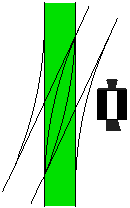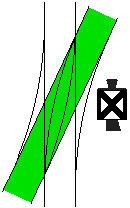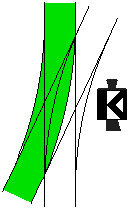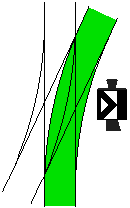|
|
|
|
|
|
|
Standard turnouts. |
|
|
|
|
Turnouts whith equal speed limit in both branches. |
||
|
|
|
|
|
Double slip-switches. |
 |
 |
 |
Light signal for standard turnouts. |

|

|

|

|
In Switzerland so-called »Jäger« signals are used.

|

|

|

|
|
Straight track in »main« direction, i.e. parallel to the axis of the station. |
Straight track in »secondary« direction. |
|
|
|
Fouling point markers
(Sicherheitszeichen) |

|
|

|
|
|
Sections with track-release equipment
(Kennzeichnung der Gleisfreimeldeeinrichtung) |
If a train route ends at a turnout leading into a dead track, the points signal is equipped with a dead track signal.
|
|
|
|
Dead track
(Stumpengleis) |
|
|
Switches without rotating turnout signals (double slip switches) have such a rotating lantern installed. |
|
|
|
|
Turnout signal as seen from the frog. The lower part of the signal is green. The turnout may be passed from either branch. |
|
|
|
|
On not-illuminated turnout signals orange boards labeled »A« or »T« are used. The letter »A« is used in the german speaking parts of Switzerland (»aufschneidbar«) and the letter »T« in the french speaking areas (»talonnable«). Both stand for »trailable«. |

|

|
|
Turnouts may passed normally (white arrows) or trailed (green arrows). |
|
Turnouts in mixed gauge tracks where one branch is only passable for one gauge have additional boards on their turnout signals.
|
|
|
Stop for narrow gauge vehicles. |
|
|
|
Stop for standard gauge vehicles. |

|

|

|

|
(Last Update: 17.11.2002)
![]() This website is published under a creative commons license.
Furthermore, use of the contents in the wikipedia is explicitely allowed.
This website is published under a creative commons license.
Furthermore, use of the contents in the wikipedia is explicitely allowed.
Errors and Omissions excepted!